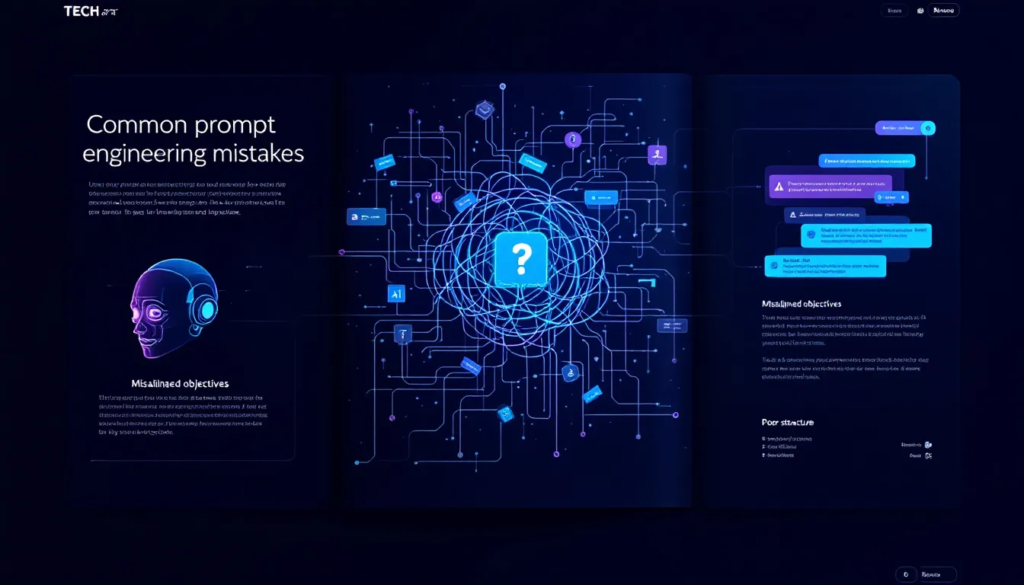Want to get better responses from ChatGPT? This article covers chatgpt prompt engineering techniques that will help you craft precise prompts and achieve optimal results. You’ll learn the best practices and avoid common mistakes, ensuring your AI interactions are efficient and effective.
Key Takeaways
– Prompt engineering is crucial for guiding AI models to generate relevant responses, highlighting the importance of specificity and context.
– Effective prompts can be basic or advanced, with advanced prompts incorporating techniques like few-shot learning and chain-of-thought reasoning to enhance accuracy.
– Continuous optimization and customization of prompts tailored to specific audiences significantly improve AI interactions and application performance.
Understanding Prompt Engineering

At its core, prompt engineering involves crafting specific inputs that guide AI models to generate the desired outputs effectively. A well-engineered prompt can make the difference between a coherent, contextually relevant response and a muddled or irrelevant one. It’s about speaking the AI’s language, providing just the right amount of detail and context to achieve optimal results.
Developers will learn important best practices for both writing prompts and application development in Python. Understanding how to use large language models effectively enables the creation of powerful, tailored AI-driven solutions.
Writing Effective Prompts
Writing effective prompts combines art and science. Specificity and detail can significantly enhance AI response quality. Context within prompts improves the AI’s understanding and accuracy; for example, clearly defining the format for a formal report can make a significant difference.
Instructing the AI to assume specific roles can lead to more tailored outputs. Responses will vary significantly if the AI is asked to act as a customer service representative versus a technical expert. Specifying the audience and tone further refines the output to fit the intended context.
Structured and organized formatting consistently yields better results than focusing solely on word choice. Iteratively build on prompts allows for more precise outputs as more context is provided. This iterative refinement is crucial, as it hones in on the most effective ways to communicate with your AI.
Basic Prompts vs. Advanced Prompts

Basic prompts often consist of straightforward questions or commands, while advanced prompts incorporate complex structures to direct responses more effectively. The choice between basic and advanced prompts can significantly influence the quality and relevance of the generated good prompts.
Advanced prompts often incorporate feedback loops and adjustments based on previous outputs. A common mistake is making prompts overly complicated, which can confuse the AI and lead to irrelevant answers. Simplifying while maintaining clarity is crucial.
Insufficient detail in prompts can result in generic AI responses. To guide the AI effectively, consider the following:
– Include enough context to provide clear guidance.
– Use clear and precise phrasing to convey the intended message accurately.
– Arrange information logically, often using lists or steps, to improve clarity and prevent disorganized responses.
Hands-On Examples
Practical examples are crucial for mastering prompt engineering. Tools like PromptAppGPT enable rapid development of applications using prompts and support low-code functionality. Dust provides a user-friendly interface for chaining prompts and integrating various model outputs.
Participants will practice writing and iterating on prompts using the OpenAI API, refining their skills through practical, real-world applications.
Zero-Shot Approach
Zero-shot prompting allows models to perform tasks without examples, relying solely on their training to understand the instructions. This approach can be powerful, but also challenging, as the model must generate responses based entirely on the prompt provided.
Added phrases like “Let’s think step by step” can significantly improve response accuracy in zero-shot scenarios. Continuous refinement of prompts is crucial for achieving high-quality AI responses.
Few-Shot Learning
Few-shot learning involves providing the model with a small number of short examples to guide its responses, enhancing performance on specific tasks. Combining multiple examples in a prompt means helping the model learn and generalize better from fewer instances, which meets its needs. This process can be seen as a review of the model’s capabilities to share knowledge.
This technique improves response accuracy by including a few examples with the instruction, making it valuable in prompt engineering. Advanced prompts can use few-shot prompting to provide context and guide the model effectively.
Chain-of-Thought Reasoning
Chain-of-thought prompting breaks down complex concepts problems into intermediate steps, leading to more accurate results in mind day. This method helps address complex tasks by enabling the model to process information step-by-step, improving response accuracy in this section in a way.
Chain-of-thought reasoning encourages models to articulate their thought process, resulting in more sophisticated outputs. This technique enhances complex prompt formulation by enabling the model to work through reasoning steps before reaching a conclusion.
Common Mistakes in Prompt Engineering

Expecting AI to engage with prompts beyond its capabilities can lead to incorrect answers. Understanding the limitations of AI models allows users to craft more effective prompts and content. Customizing prompts for the target audience is crucial, as tailoring complexity and style based on audience knowledge enhances response effectiveness and helps AI to respond appropriately.
Effective prompts help prevent misuse of AI by:
– Clearly defining expected contexts and responses.
– Avoiding unnecessary examples, as advanced AI models often perform worse with them.
– Emphasizing the importance of clear instructions.
– Providing feedback on AI responses to improve future interactions and accuracy.
Prompt performance can deteriorate over time due to changes in models, data distributions, and user behavior. Continuous optimization is essential. Effective prompt engineering practices significantly enhance the efficiency of AI applications.
Industry Experts’ Insights
Prompt engineering bridges the communication gap between end users and AI models. Companies optimizing their prompt engineering based on empirical evidence often achieve better performance and lower costs.
Companies making over $50 million annually with AI features prioritize systematic prompt testing and improvement over relying solely on human iteration. Hands-on exercises in prompt engineering can significantly enhance learners’ ability to create effective prompts in just a few hours. Be sure to check the results regularly.
Tools and Resources
Participants will refine prompts using the OpenAI API for real-world applications, engaging in practical exercises to hone their skills. OpenPrompt is an open-source framework for prompt learning with pre-trained language models. PTPT is a command-line tool for converting text files using predefined prompts.
Google’s ‘Prompting Essentials’ course on Coursera offers:
– Introduction to effective prompt design.
– A certificate from Google upon completion, enhancing professional credentials.
– Hands-on activities that reinforce learning by allowing participants to practice real-world prompting challenges.
LangChain is a library designed to help developers integrate large language models with other computational resources. These tools and resources are essential for building robust AI applications and enhancing prompt engineering practices.
Case Studies
Case studies play a critical role in demonstrating the real-world efficacy of prompt engineering techniques. LLM is an open-source platform promoting the development of generative AI applications without coding skills. By enabling users to create robust AI applications without programming knowledge, LLM democratizes access to generative AI technology.
Platforms like LLMStack could spur innovation and broaden the application of AI technologies across various fields.
Summary

Mastering prompt engineering is essential for anyone looking to leverage the full potential of AI. From understanding the basics to implementing advanced techniques, this guide has covered the key aspects of writing effective prompts.
By following best practices and learning from industry experts, you can create powerful AI-driven solutions tailored to your needs. Remember, the journey doesn’t end here; continuous learning and refinement are crucial to staying ahead in the AI landscape.

Leave a Reply